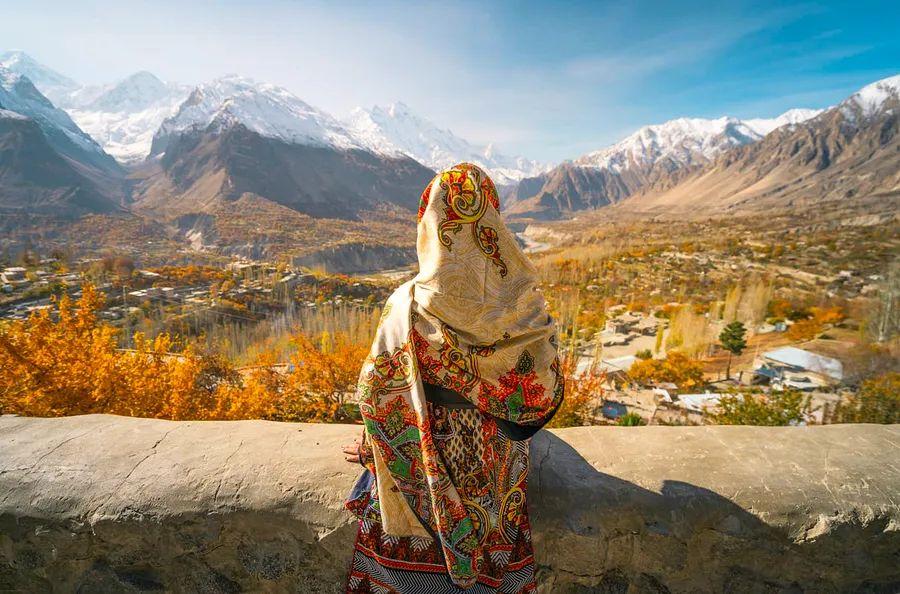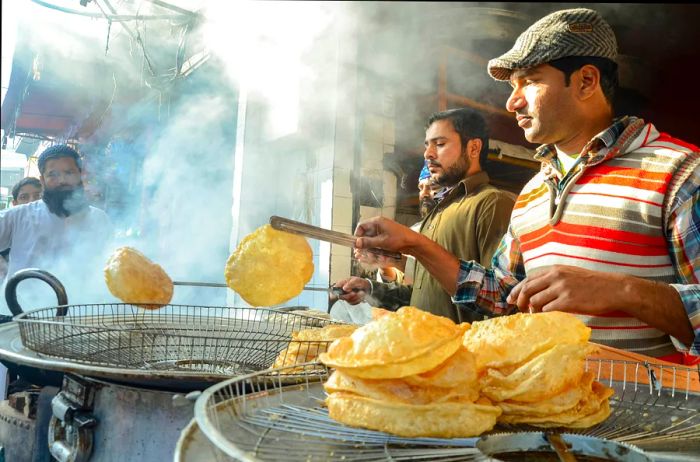14 Incredible Experiences to Have in Pakistan

Pakistan is widely recognized as an adventure tourism hotspot, but its deep history and vibrant culture make it appealing to all types of travelers.
While Lahore and Karachi offer numerous attractions, venturing beyond these bustling cities to explore the stunning mountains of Gilgit-Baltistan, ancient archaeological sites, and colonial hill stations is highly rewarding.
Our curated list of the top activities in Pakistan will guide you from the shores of the Arabian Sea to the peaks of the Karakoram Mountains, showcasing the diverse wonders of the country.
 Explore the vibrant food streets of Lahore © Bay_Media / Shutterstock
Explore the vibrant food streets of Lahore © Bay_Media / Shutterstock1. Indulge in the culinary delights of Lahore’s food streets
Follow your appetite as you explore Lahore. The city boasts numerous streets famous for their street food, and during the evening, the air is filled with enticing aromas of spices and grilled meats. Gawalmandi Food Street and Fort Street offer an outstanding variety of food stalls, while Old Anarkali Food Street also has plenty to offer.
In addition to the deliciously spiced kebabs, make sure to sample katlama (deep-fried bread marinated in tomato and chili paste, served with lentils) and grato jalebi—vibrant, cardamom-infused sweets fried fresh in hot oil.
Tip for visitors: Most food stalls open in the evening, so aim to arrive after 6pm for the best choices.
2. Experience polo at Shandur Top
The Shandur Pass feels like it’s at the peak of the world, standing at 3700m (12,139ft) above sea level. It also hosts Pakistan’s most intense polo tournament—teams from Chitral and Gilgit compete under freestyle rules during the annual Shandur Polo Festival in early July, attracting up to 40,000 spectators. Join the crowd for an unforgettable experience in Pakistan.
Tip for visitors: Take ample time to acclimate to the altitude at Shandur Top, ensuring you can fully enjoy the festival without feeling dizzy or out of breath.
3. Connect with the Kalash people in Chitral
The Kalash community in Chitral District is one of the few indigenous groups in Pakistan that still uphold traditional customs. They practice animism, including making sacrifices, speak their own language, Kalasha, and don unique traditional attire. For an extraordinary experience, try to plan your visit around a Kalash festival—the most significant being Chawmos, which coincides with the Winter Solstice and features music, dance, and the ritual purification of participants.
 Navigating the Hussaini Hanging Bridge ranks among the most thrilling experiences in Pakistan © Wu Swee Ong / Getty Images
Navigating the Hussaini Hanging Bridge ranks among the most thrilling experiences in Pakistan © Wu Swee Ong / Getty Images4. Conquer the hanging bridges of Gilgit-Baltistan
Suspended above rushing rivers in Gilgit-Baltistan, you’ll find a series of rickety bridges constructed from wooden planks tied together with rope. If you’re seeking adventurous activities in Pakistan and aren’t afraid of heights, this is perfect for you. For an extra thrill, you can also traverse some rivers using basic zip lines.
Side trip: Pair your visit to the Hussaini Hanging Bridge in Gojal with a journey to the stunning Hunza Valley, often regarded as the original Shangri La.
5. Uncover the Bronze Age heritage of Pakistan at Moenjodaro
The Indus Valley Civilization birthed one of the earliest cities, Moenjodaro, around 2500 BCE. This extraordinary archaeological site was not rediscovered until the 1920s and is now recognized as a UNESCO World Heritage Site. You can see the city's well-planned layout, featuring a neat grid of streets flanked by residential and administrative buildings, alongside a grand citadel, guard towers, over 700 wells, and public baths. These ancient residents certainly knew how to live!
Travel tip: Moenjodaro is situated on the banks of the River Indus near Larkana—plan your visit for the afternoon to enjoy an evening boat ride on a flat-bottomed vessel.
6. Visit the rock-carved Buddha in Swat
Prior to the spread of Islam, Pakistan had a significant Buddhist community, flourishing under the Kushan Empire. In the Swat Valley, you’ll find not just temples and stupas, but also stunning relief carvings of the Buddha. The 7th-century Buddha of Swat, located near Mingora, was damaged by the Taliban in 2007 but has since been restored, now radiating peace in the lotus position once more.
Travel tip: Inquire about the current security conditions before traveling to Swat, as the area can experience sporadic tensions.
7. Explore Sufism in Multan
Known as the “City of Saints,” Multan boasts a rich history tied to numerous Sufi mystics from the 11th and 12th centuries. Their tombs are architectural wonders, but the true enchantment lies in their enduring cultural impact, particularly in Pakistani poetry, music, and dance. Experiencing the haunting sounds of qawwalis (devotional songs) reverberating through the shrines of Multan is a magical moment that sends shivers down your spine.
Travel tip: Look up the dates for the annual Urs festival at the Tomb of Shah Rukn-e-Alam and consider avoiding this busy period, as over 100,000 pilgrims gather, making Multan quite congested.
 Relish the evening glow over Lahore's Badshahi Mosque © Oleh_Slobodeniuk / Getty Images
Relish the evening glow over Lahore's Badshahi Mosque © Oleh_Slobodeniuk / Getty Images8. Watch the sunset at the Badshahi Mosque in Lahore
With so many activities to enjoy in Lahore, it can feel overwhelming. Set aside an hour or two at dusk to witness the sunset at the stunning 17th-century Badshahi Mosque. Erected by Mughal Emperor Aurangzeb, this gem of Indo-Islamic architecture showcases a pink sandstone facade and striking white marble domes, which are especially captivating in the evening light. The mosque welcomes visitors until about 8pm.
Travel tip: For a unique perspective of the mosque, make your way to the rooftop of Cooco’s Den, a traditional haveli beautifully restored by artist Iqbal Hussain.
9. Dive into cultural heritage at the Lok Virsa Museum in Islamabad
The Lok Virsa Museum in Islamabad is the largest museum in Pakistan, showcasing the country’s rich cultural heritage, both past and present. It ranks among the top attractions in Pakistan as it unites the living traditions of all ethnic groups in one place. The exhibits, featuring sculptures, textiles, jewelry, and woodwork, reflect the craftsmanship of artisans over the centuries, and there’s also a vast archive of audio and video recordings.
10. Explore street stalls at Rawalpindi’s Raja Bazaar
A market offers a glimpse into a nation's essence, and Rawalpindi’s renowned Raja Bazaar is ideal for people-watching. To gain a deeper understanding of Pakistan, spend a morning here hunting for second-hand books, costume jewelry, and unique local souvenirs. You can also treat yourself to freshly squeezed juices and crispy snacks while you browse.
11. Take the bus to the hill station of Murree
Established by the British in the 1850s, this beautiful hill station served as a summer retreat for colonial officials. Landmarks like the Holy Trinity Church and the General Post Office are historical remnants of the Raj, while modern attractions like gondolas and chair lifts cater to a new wave of domestic tourists, offering breathtaking views. Catch a colorful local bus from Rawalpindi to Murree for a journey that’s just as memorable as the destination.
Planning tip: For stunning vistas in Murree, make your way to the elevated Kashmir Point, located about a kilometer from the post office along Mall Road.
 One of the top adventures in Pakistan is driving along the Karakoram Highway © Shehzaad Maroof / Getty Images
One of the top adventures in Pakistan is driving along the Karakoram Highway © Shehzaad Maroof / Getty Images12. Embark on a journey along the Karakoram Highway from Islamabad to the Khunjerab Pass
The Karakoram Highway is undeniably one of the most epic road trips in the world. Stretching 1300km (808 miles), it begins in Hasan Abdal in southern Pakistan and concludes at Kashgar in China, but the stretch between Islamabad and the China-Pakistan border offers the most breathtaking landscapes.
While a few adventurous cyclists and motorbikers take on the route solo, it's far more common to travel by shared or chartered 4WD vehicles or local buses. Along the journey, you'll be treated to views of the towering peaks of 8126m (26,660ft) Nanga Parbat and 7788m (25,551ft) Rakaposhi.
Planning tip: The Khunjerab Pass is off-limits to all vehicles from December 30 to April 1 due to icy conditions, so keep this in mind if you're heading to China.
13. Hike to the Fairy Meadows
With mountains dominating the northern region, hiking is undoubtedly among the top activities in Pakistan. There’s no direct road to the breathtaking Fairy Meadows, but from late spring to early autumn, you can reach Tatu village by 4WD and then trek for three to four hours on foot. While you won’t encounter fairies here, the enchanting scenery makes up for it, and with camping as the best accommodation option, you can spend the night marveling at the stunning stars above.
Detour: If you’re up for a challenge, consider extending your adventure with a trek to Nanga Parbat Base Camp after visiting Fairy Meadows.
14. Honor Jinnah at the Quaid-i-Azam in Karachi
Muhammad Ali Jinnah is revered as the father of Pakistan and served as its first governor-general. His striking white marble tomb in Karachi was crafted in the 1960s with a modernist design, inspired by the 10th-century Ismail Samani Mausoleum in Bukhara, Uzbekistan. Set within a sprawling 53-hectare park, the Quaid-i-Azam is beautifully illuminated at night, offering stunning opportunities for evening photography.

1

2

3

4

5
Evaluation :
5/5